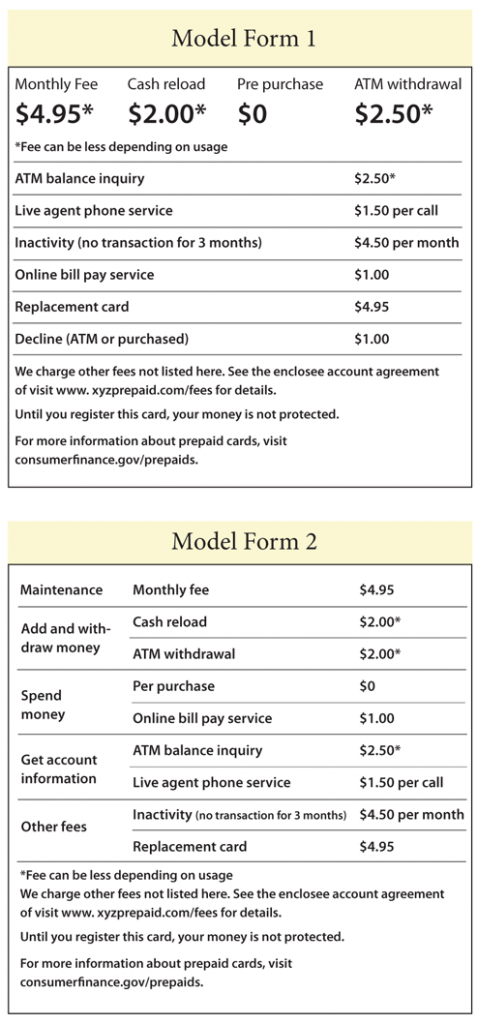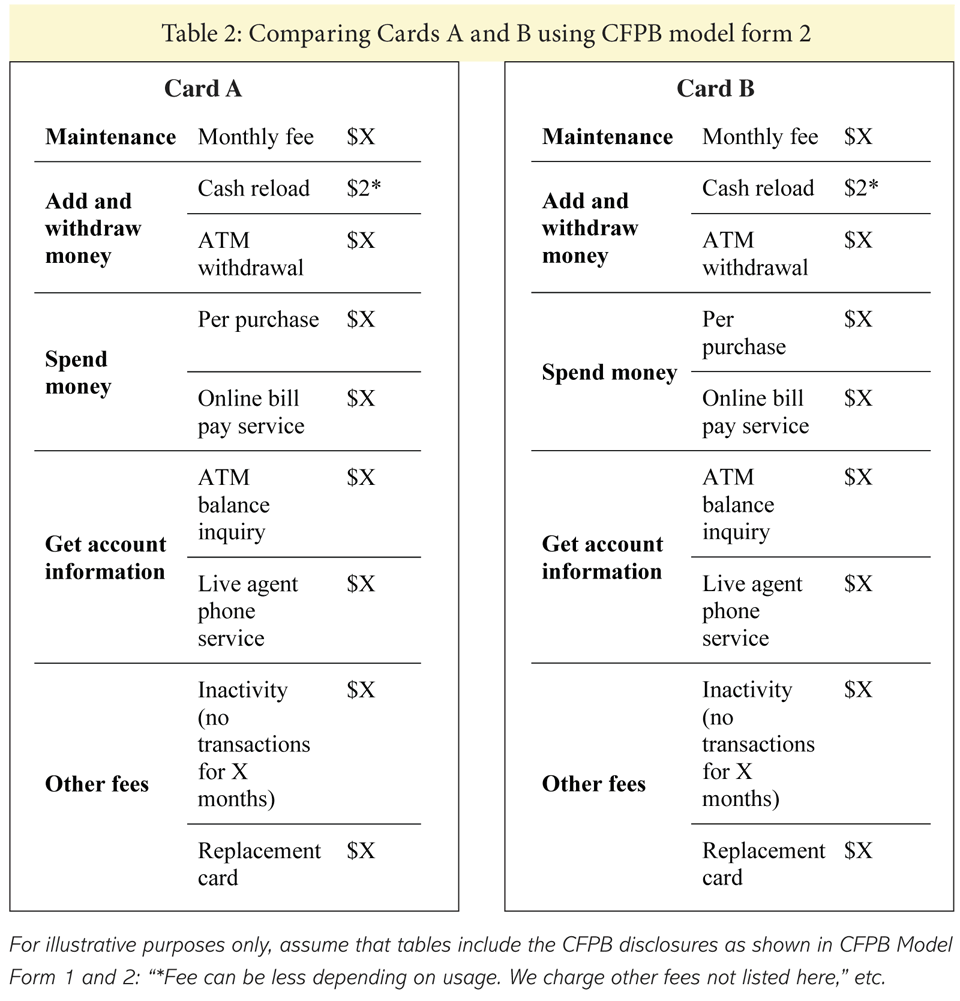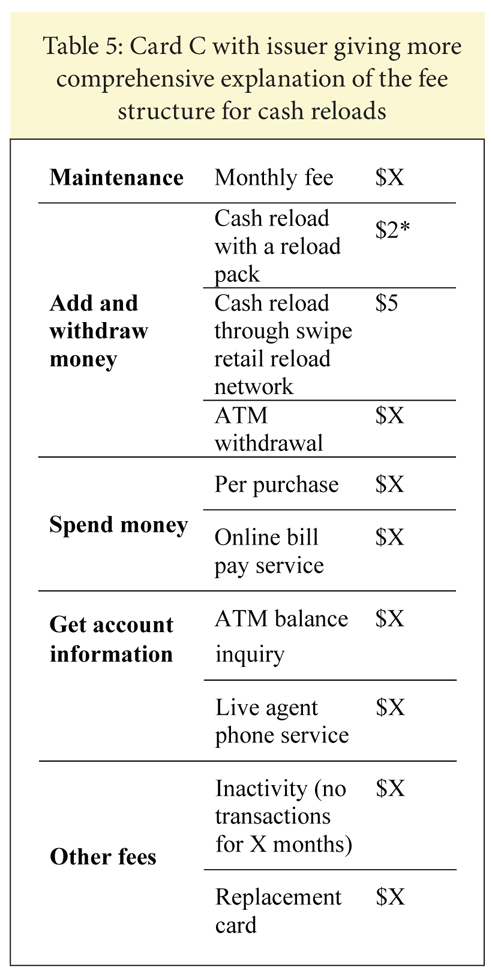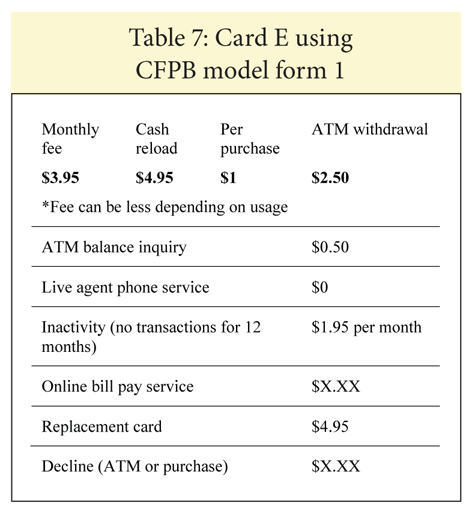Viewpoint: CFPB’s Draft Model Forms Highlight Problems with Uniform Disclosures

 By David L. Beam, K&L Gates LLP
By David L. Beam, K&L Gates LLP
Uniform disclosure forms are a tricky thing. Done well, they can facilitate an apples-to-apples comparison that enhances competition and protects both consumers and honest competitors. But if not designed carefully, a uniform disclosure form might facilitate an apples-to-apples comparison by effectively banning the sale of oranges. Uniform disclosure rules also need to be crafted to prevent the unscrupulous apple merchant from gaming the system and making the disclosures for the rotten apple look good.
On March 18, the CFPB posted a blog entry, which included its current working drafts of two fee disclosure boxes for GPR cards. The CFPB is testing the model fee disclosure boxes with consumers and is seeking input on the forms. The CFPB’s goal is to include a uniform fee disclosure box in the proposed rule on GPR cards that, it says, will be released later this spring.
Will the CFPB’s model fee disclosure boxes enhance competition—or will they stifle innovation and product diversity in the prepaid card industry? It’s too soon to tell. Aside from the fact that the model forms are still works in progress, the CFPB’s blog entry didn’t provide information about how the information in the forms will be populated, or whether and to what extent issuers will be permitted to modify the forms to account for the specifics of their products. These details will be crucial. It is not too soon, however, to offer some initial thoughts and impressions of the CFPB’s drafts. This is especially true because it’s better to take up the CFPB’s invitation to provide constructive feedback now than to wait until the CFPB formally proposes a model form.
A Look at the Models
The blog shows pictures of fee disclosure tables on the retail packaging of four actual GPR card products. To this author, each of these disclosure tables clearly conveys the respective product’s fee terms in a way that’s easy for consumers to digest and understand. But the blog said the CFPB is concerned that “each prepaid card has a different style and format for presenting fee and other important information.” This, according to the CFPB, “could make it difficult to find the information important to [the consumer] and to compare fee information between cards.” The CFPB plans to solve this perceived problem by “developing a model disclosure form to standardize these disclosures to include in the proposed rule.”
The blog post then shows two model disclosure forms the CFPB is testing with consumers. (See Model Form 1 and Model Form 2.) Both forms present the same information, although the format of each is slightly different.
The CFPB’s Model Form 2 resembles the model fee disclosure box proposed by the Center for Financial Services Innovation (CFSI) in 2012.[i] Like the CFSI box, the CFPB’s Form 2 divides the fees into categories. The CFPB’s categories are similar (but not identical) to the categories CFSI proposed. Form 1 also incorporates aspects of CFSI’s model box.
The CFPB appears to be following CFSI’s suggestion that the model form should not attempt to list every fee the cardholder conceivably could incur.[ii] Instead, the two forms appear designed to focus on the fees that the CFPB considers to be the most important. The forms also disclose that the issuer charges fees other than those listed in the box and directs the consumer to a comprehensive online list of fees. (This approach is different from the approach used in a model fee disclosure box designed by the Pew Charitable Trusts; Pew’s box would contain every fee the consumer could incur.[iii])
Comments and Questions on the Model Forms
CFSI’s model disclosure box enjoys broad support within the prepaid industry, so the fact that the CFPB is drawing inspiration from CFSI is good news. Merely incorporating the format and visual design of CFSI’s box, however, might not be enough. CFSI’s model box was part of a comprehensive set of principles on uniformity in prepaid card fee disclosures, which it outlined in the white paper that accompanied the model box. The crucial overall question not addressed in the CFPB’s blog is whether and to what extent the CFPB plans to incorporate CFSI’s principles in the regulations that govern the use of the uniform fee disclosure box.
Below are some specific questions the blog doesn’t consider but that are crucial to addressing the sufficiency of the CFPB fee disclosure box proposals.
Q1: Must the issuer list these exact fees?
The CFPB’s blog post did not indicate—one way or the other—whether the CFPB plans to require the issuer to disclose exactly the fees in the model box or whether the issuer would have flexibility to decide which fees to include in its box. If the CFPB requires the issuer to disclose the specific fees listed in the model box—and no others—then, this will be a significant departure from CFSI’s proposal. It also could actually discourage transparency.
The CFSI emphasized in the report accompanying its model form that the box “should be mandated in a way that allows industry some flexibility to add on to it or customize it for their customers.” In particular, “CFSI believes that each company’s fee box should include the specific fees that its customers most frequently pay, appropriately categorized” (emphasis added).
This flexibility was integral to CFSI’s proposal, but it’s not clear whether the CFPB is planning to provide issuers with similar flexibility.
 To illustrate why this flexibility is so important, take this example involving reload fees. Assume for purposes of this example that the CFPB plans to require each issuer to disclose exactly the fees listed in the model disclosures, and only those fees. The CFPB’s model forms would require the issuer to disclose the fees for cash reloads, but not other kinds of reloads (e.g., ACH transfers from a linked bank account or direct deposits). The CFPB likely focused on cash reloads because fees for noncash reload methods are relatively uncommon today. However, fees for noncash reloads could become much more common if the CFPB requires issuers to focus on cash reload fees in the disclosure.
To illustrate why this flexibility is so important, take this example involving reload fees. Assume for purposes of this example that the CFPB plans to require each issuer to disclose exactly the fees listed in the model disclosures, and only those fees. The CFPB’s model forms would require the issuer to disclose the fees for cash reloads, but not other kinds of reloads (e.g., ACH transfers from a linked bank account or direct deposits). The CFPB likely focused on cash reloads because fees for noncash reload methods are relatively uncommon today. However, fees for noncash reloads could become much more common if the CFPB requires issuers to focus on cash reload fees in the disclosure.
The fee schedules for reloads for the two cards are shown on Table 1.
Card A’s schedule of reload fees is the better option for consumers. Both cards offer only one cash reload method, and both cards charge the same fee for this method. Card B, however, charges a fee for every load, including direct deposits.
 If the CFPB doesn’t provide issuers with flexibility to decide which fees to disclose in the box, the two disclosure forms would look like Table 2.
If the CFPB doesn’t provide issuers with flexibility to decide which fees to disclose in the box, the two disclosure forms would look like Table 2.
With the CFPB’s model form, the fee box for both cards would indicate that the “cash reload” fee is $2. As a result, a consumer might conclude that the cards are a wash when it comes to reload costs—even though the reload fees for many cardholders will be higher with Card B.
The disclosures might be even more misleading if Card B charged only $1.50 for the swipe reload. In that situation, the fee box for Card A would disclose a cash reload fee of $2, whereas the fee box for Card B would disclose a cash reload fee of only $1.50. This might suggest to the consumer that reloading Card B is less expensive overall—even though the undisclosed fees for noncash reloads could result in significantly higher overall reload costs for many consumers.
 If the CFPB gives issuers flexibility to determine which fees they will disclose, then the Card A issuer could avoid this concern by listing the fee for each reload method separately. Card A’s fee box might look like the illustration shown in Table 3.
If the CFPB gives issuers flexibility to determine which fees they will disclose, then the Card A issuer could avoid this concern by listing the fee for each reload method separately. Card A’s fee box might look like the illustration shown in Table 3.
This fee box gives the consumer crucial information. As CFSI observed in the report it released with its model box, highlighting free services is a subtle, but important, way to encourage lower-cost use of prepaid cards.[iv]
Q2: How will the issuer determine the amount of the disclosed fee?
If the CFPB requires the issuer to disclose the exact fees listed in the model form—and only those fees—then another question is how the issuer must determine the amount to disclose if the amount of the fee could vary.
 Take the example shown in Table 4. If the issuer cannot modify the fees disclosed in the CFPB’s box, then each issuer would be required to disclose a single fee for “cash reload.” For Card D, this amount would be $3, because $3 is the fee for the only cash reload method available with Card D. But what amount should be disclosed for Card C?
Take the example shown in Table 4. If the issuer cannot modify the fees disclosed in the CFPB’s box, then each issuer would be required to disclose a single fee for “cash reload.” For Card D, this amount would be $3, because $3 is the fee for the only cash reload method available with Card D. But what amount should be disclosed for Card C?
One approach would be to require the issuer to disclose the highest possible fee. The fact that the CFPB’s disclosure box says that fees might be less (not just different) depending on usage suggests that this might be what the CFPB is contemplating. The example above shows why requiring the issuer to disclose the highest possible fee might not provide the consumer with more accurate information, however. In the example, Card C is clearly the better option from a cash reload fee perspective. The cost to reload with a reload pack is actually higher with Card D. Card C gives the consumer an additional option that is more expensive—but which the consumer may choose not to use. A consumer who regularly reloads with a reload pack would incur greater reload fees with Card D. However, the CFPB’s model form would make Card D look like the less expensive option from a reload fee standpoint. The model disclosure for Card C would say that the cash reload fee is $5, whereas the model disclosure for Card D would say that the cash reload fee is $3. A consumer who is concerned about cash reload fees will be steered to Card D.
 The result of this is that the Card C issuer might decide to drop the swipe reload option. This would be bad for consumers. Some consumers might not consider the relative convenience of a swipe reload versus a reload pack to be worth the extra $3. Those consumers still could use reload packs (which is the only option under Card D), but some might be willing to pay a little bit extra for the added convenience of a swipe reload service. This won’t be an option if the Card C issuer decides it must drop the swipe reload feature to keep the disclosed cash reload fee as low as possible.
The result of this is that the Card C issuer might decide to drop the swipe reload option. This would be bad for consumers. Some consumers might not consider the relative convenience of a swipe reload versus a reload pack to be worth the extra $3. Those consumers still could use reload packs (which is the only option under Card D), but some might be willing to pay a little bit extra for the added convenience of a swipe reload service. This won’t be an option if the Card C issuer decides it must drop the swipe reload feature to keep the disclosed cash reload fee as low as possible.
This should not be a concern if the CFPB gives the issuer flexibility to decide which fees to include in the disclosure box. If the Card C issuer had this flexibility, then it could give the consumer a more comprehensive explanation of the fee structure for cash reloads, as shown on Table 5.
Now, the consumer would know that a reload with a reload pack costs only $2. When the consumer compares the Card C box with the Card D box, the consumer would see that the cost to reload with a reload pack is $2 for Card C and $3 for Card D (and probably would infer from the absence of a fee disclosure for swipe retail reloads in Card D’s box that Card D does not provide this option).
Q3: How would issuers disclose alternative fee plans?
It’s not clear from the blog how the issuer would complete the form for a card product that gives the consumer the option of choosing from several different plans, each with a different fee schedule.
 To illustrate, imagine Card E offers the cardholder a choice of two separate plans: (1) a monthly fee plan and (2) a transaction fee plan. The fees for the two plans are shown in Table 6.
To illustrate, imagine Card E offers the cardholder a choice of two separate plans: (1) a monthly fee plan and (2) a transaction fee plan. The fees for the two plans are shown in Table 6.
A consumer who plans to use the card as his primary payment card probably will opt for the monthly fee plan. Consumers who want a card for more limited purposes might find the transaction fee plan the better deal.
It’s not clear how an issuer would convey differences in the plans with the CFPB’s model disclosures. One possibility is the CFPB would say that for each fee, the issuer must disclose the highest possible fee under any plan. If so, Table 7 shows what Card E’s fee box might look like (if the CFPB chooses the model 1 form).
 This disclosure box doesn’t convey the options available to the consumer. The consumer will pay a $3.95 monthly fee if he chooses the monthly fee plan. The consumer will incur a $1 charge for each purchase transaction if he chooses the per transaction plan. But, there’s no way the consumer will incur both a $3.95 monthly fee and a $1 charge for each purchase transaction. The model disclosure in Table 7 suggests that the consumer will incur both these fees, however.
This disclosure box doesn’t convey the options available to the consumer. The consumer will pay a $3.95 monthly fee if he chooses the monthly fee plan. The consumer will incur a $1 charge for each purchase transaction if he chooses the per transaction plan. But, there’s no way the consumer will incur both a $3.95 monthly fee and a $1 charge for each purchase transaction. The model disclosure in Table 7 suggests that the consumer will incur both these fees, however.
Imagine Card E sitting on the shelf next to Card F with only one plan, which has the following terms:
- Monthly Fee: $3.95
- Transaction Fee: $0.50 per transaction
- Inactivity fee: $1 per month
- Reload Fee: Same as Card E
- ATM Withdrawals: Same as Card E
 The cardholder who chooses Card F will incur a monthly fee and a $0.50 fee per transaction and a $1 per month inactivity fee. In contrast, the holder of Card E who chooses the monthly fee plan will incur no purchase transaction fees or inactivity fees. The fee box for Card F, however, would make Card F look like the better option, as illustrated in Table 8.
The cardholder who chooses Card F will incur a monthly fee and a $0.50 fee per transaction and a $1 per month inactivity fee. In contrast, the holder of Card E who chooses the monthly fee plan will incur no purchase transaction fees or inactivity fees. The fee box for Card F, however, would make Card F look like the better option, as illustrated in Table 8.
The consumer who compares Card F’s disclosure to Card E’s disclosure will think that Card F offers a better deal because Card F has lower purchase transaction fees and lower inactivity fees. The consumer wouldn’t realize that he could avoid purchase transaction fees and inactivity fees altogether if he purchased Card E and chose the monthly fee plan.
The result? The issuer of Card E might decide that it needs to jettison the transaction fee plan, so as not to be required to include the fees for the transaction fee plan in the disclosure. Losing the option of the transaction fee plan might not be a big deal for the consumer who would choose the monthly fee plan anyway. But, for those consumers who might have benefited from the transaction fee plan, this option no longer will be available.
The CFPB will need to consider this issue when it crafts the rules governing the cards. It will be important for the CFPB to give the issuer enough flexibility to modify the form to convey the different costs for different plans.
Conclusions
The CFPB should be commended for its efforts to encourage transparency and clarity in GPR card disclosures. It also should be commended for sharing its working draft with the public before making a formal rule proposal.
Whether the CFPB’s model form succeeds in empowering consumers will depend on the answers to a number of additional questions not addressed in its blog post. The industry should take the CFPB’s invitation to comment on the proposed forms by addressing these unanswered questions.
David L. Beam is a partner with K&L Gates LLP, a global law firm with 48 offices on five continents. David, who is based in the firm’s Washington, D.C., office, has a national practice advising clients on compliance with state and federal laws that regulate payments in the U.S., and his global colleagues advise clients on laws regulating payment systems and products in countries around the world. Reach him at [email protected].
[i] Center for Financial Services Innovation, Thinking Inside the Box: Improving Consumer Outcomes Through Better Fee Disclosure for Prepaid Cards 10 (March 2012)
[ii] See Thinking Inside the Box at 12-13.
[iii] Pew Charitable Trusts, The Need for Improved Disclosures for General Purpose Reloadable Prepaid Cards 8 (March 2014).
[iv] See Thinking Inside the Box at 13.











































